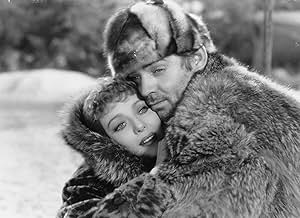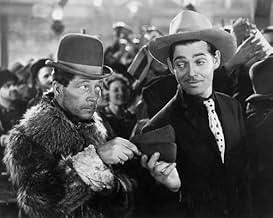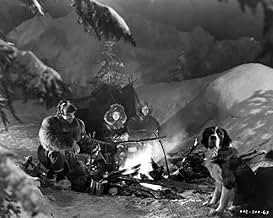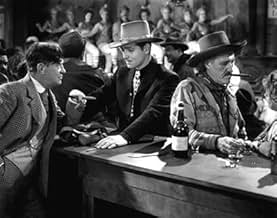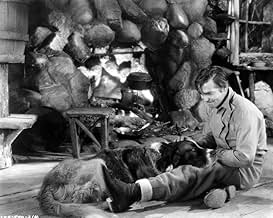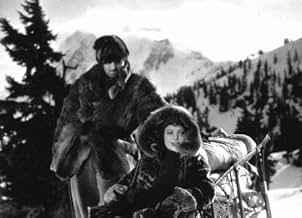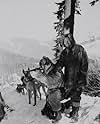IMDb-BEWERTUNG
6,8/10
2759
IHRE BEWERTUNG
Während des Klondike-Goldrausches kauft ein Reisender einen Hund, der ihm den Weg zum Schatz weist, überlegt aber seine Reise noch einmal, als er eine sitzen gelassene verheiratete Frau find... Alles lesenWährend des Klondike-Goldrausches kauft ein Reisender einen Hund, der ihm den Weg zum Schatz weist, überlegt aber seine Reise noch einmal, als er eine sitzen gelassene verheiratete Frau findet.Während des Klondike-Goldrausches kauft ein Reisender einen Hund, der ihm den Weg zum Schatz weist, überlegt aber seine Reise noch einmal, als er eine sitzen gelassene verheiratete Frau findet.
- Regie
- Drehbuch
- Hauptbesetzung
- Auszeichnungen
- 1 wins total
Thomas E. Jackson
- 'Tex' Rickard
- (as Tommy Jackson)
George MacQuarrie
- Mounted Policeman
- (as George McQuarrie)
C.E. Anderson
- Fourth Poker Player
- (Nicht genannt)
Edwin Argus
- Dawson Townsman
- (Nicht genannt)
William Arnold
- First Faro Player
- (Nicht genannt)
Empfohlene Bewertungen
Clark Gable meets Loretta Young in this 1930s adaptation of Jack London's The Call of the Wild, which takes place in Alaskan territory. I've never read the book, but I can only imagine that this was probably not very faithful to the novel, due to its emphasis of comic relief by supporting actor Jack Oakie. This is the movie that changed Clark and Loretta's life, as they fell in love during the making of this film, and she went away in private to have his baby - a fact she never told the public. While that may be neither here nor there, in reviewing this film, it's pretty evident that something was going on, by their quiet scenes together, which are very intimate and deep, considering this is a 1930s film. The plot revolves around a map that is needed to find a gold mine. Her husband, yes her husband, was the owner of the map, but Clark and Jack go after the gold mine, with Jack's memory and a rough sketch of it to use. They find Loretta alone, after her husband has been lost in the wilderness looking for help. Reginald Owen is very good and memorable as a nemesis in trying to find the gold mine too, when he learns of it. The production values and performances are solid and deliver the goods, but its corny comic relief mars the film's attempt to hit the mark with viewers, especially with its abrupt ending. I thought the novel was mainly about the dog, but, while the dog, who Clark is attached to, does have some screen time, the film doesn't feel like a dog film. The producers were probably thinking that would alienate some viewers, so they centered on pairing attractive leads Clark and Loretta together and Jack Oakie's one-liners. While I liked the film on the whole for Loretta's loveliness, memorable love scenes between her and Clark, and Reginald Owen's credible contribution to the film, I still feel it misses the mark for a completely fulfilling movie experience.
The Yukon Gold Rush: A savage dog and a lonely man each respond to THE CALL OF THE WILD, that primordial release of primitive urges, in their own way.
It should be understood immediately that this movie only borrows the title and a few incidents from Jack London's classic novel. And at that point the comparison between the two should end. This film, rousing & adventurous, is able to stand on its own merits. An excellent cast, fine production values (notice particularly the care with which Skagway & Dawson are depicted) and location shooting in Washington State are the film's strongest assets. The plot, meant solely for entertainment, is pure hokum...
Clark Gable brings his trademark masculinity to a role that didn't require a lot of stretching of his thespian muscles. But in essentially playing himself he is perfectly cast. One cannot overcome the suspicion that London's original story was reworked for the star. Gable had been through this before - remote setting, forces of nature, beautiful woman, adultery. Think RED DUST in the snow.
Loretta Young is the beautiful woman. From scene to scene, no matter what the hardship, she remains living proof that a first class Hollywood makeup job can withstand the worst ravages of the Klondike. This is perhaps too harsh. Like Gable, little more is required of her than to exude physicality. She is indeed a treat to the eyes, even if her inclusion in the plot is patently ludicrous. (The on screen attraction between Gable & Young wasn't faked. A daughter, ostensibly 'adopted' by Young in France, would be the result.)
As Gable's sidekick, comic Jack Oakie has one of his best screen roles. Getting to play most of his scenes strictly for laughs, he adds chuckles to the story which, one assumes, would have outraged London.
Twisting his usual pomposity to a sinister bent, English character actor Reginald Owen is memorable as the film's villain. Dangerously wicked, he makes us want to know more about this man called Smith, with money to burn and a raging temper. The screenplay, wisely, leaves his biography up to the imagination of the viewer.
Sidney Toler & Herman Bing are very good in small roles. Movie mavens will recognize Arthur Housman, veteran of many Laurel & Hardy comedy shorts, as a Skagway drunk with a surprisingly mean punch.
The affection between Gable and Buck, the great St. Bernard with whom he shares so many scenes, is obvious.
It should be understood immediately that this movie only borrows the title and a few incidents from Jack London's classic novel. And at that point the comparison between the two should end. This film, rousing & adventurous, is able to stand on its own merits. An excellent cast, fine production values (notice particularly the care with which Skagway & Dawson are depicted) and location shooting in Washington State are the film's strongest assets. The plot, meant solely for entertainment, is pure hokum...
Clark Gable brings his trademark masculinity to a role that didn't require a lot of stretching of his thespian muscles. But in essentially playing himself he is perfectly cast. One cannot overcome the suspicion that London's original story was reworked for the star. Gable had been through this before - remote setting, forces of nature, beautiful woman, adultery. Think RED DUST in the snow.
Loretta Young is the beautiful woman. From scene to scene, no matter what the hardship, she remains living proof that a first class Hollywood makeup job can withstand the worst ravages of the Klondike. This is perhaps too harsh. Like Gable, little more is required of her than to exude physicality. She is indeed a treat to the eyes, even if her inclusion in the plot is patently ludicrous. (The on screen attraction between Gable & Young wasn't faked. A daughter, ostensibly 'adopted' by Young in France, would be the result.)
As Gable's sidekick, comic Jack Oakie has one of his best screen roles. Getting to play most of his scenes strictly for laughs, he adds chuckles to the story which, one assumes, would have outraged London.
Twisting his usual pomposity to a sinister bent, English character actor Reginald Owen is memorable as the film's villain. Dangerously wicked, he makes us want to know more about this man called Smith, with money to burn and a raging temper. The screenplay, wisely, leaves his biography up to the imagination of the viewer.
Sidney Toler & Herman Bing are very good in small roles. Movie mavens will recognize Arthur Housman, veteran of many Laurel & Hardy comedy shorts, as a Skagway drunk with a surprisingly mean punch.
The affection between Gable and Buck, the great St. Bernard with whom he shares so many scenes, is obvious.
Wiliam Wellman is the director at the helm of this version of Jack London's immensely popular novel. As an adventure, this movie offers a lot of fun because of the enormous appeal of its star, Clark Gable. He is a man's man. Mr. Gable projected such an aura about himself that he carried from film to film, making him one of the favorites of all audiences. The gold rush is presented as it should have been for the people that went in search of riches in the inhospitable confines of Alaska.
In this version, Loretta Young plays Claire Blake, the woman who conquered Jack Thornton's heart. The rumored affair between Ms. Young and Mr. Gable is fun to look at. What's real, and what not? It's up to the stars to know and for us, the viewers, to guess. Ms. Young and Mr. Gable were appealing players, as they prove in this film.
In other roles, Jack Oakie, Reginald Owen, Frank Conroy, and other old faces from films of the era make wonderful appearances. Above all, Buck, the great St. Bernard dog in the film is amazing. It's a joy to watch Mr. Gable's scenes with Buck as they compliment one another in that frigid background.
In this version, Loretta Young plays Claire Blake, the woman who conquered Jack Thornton's heart. The rumored affair between Ms. Young and Mr. Gable is fun to look at. What's real, and what not? It's up to the stars to know and for us, the viewers, to guess. Ms. Young and Mr. Gable were appealing players, as they prove in this film.
In other roles, Jack Oakie, Reginald Owen, Frank Conroy, and other old faces from films of the era make wonderful appearances. Above all, Buck, the great St. Bernard dog in the film is amazing. It's a joy to watch Mr. Gable's scenes with Buck as they compliment one another in that frigid background.
The beginning of Call of the Wild (a very loose adaptation of Jack London's novel of the same name) is made up of hard to decipher plot set up exposition which I was only able to get my head around until my third viewing; surely there could have been a more interesting and engaging way the film could have delivered all this information to the viewer. Likewise, a scene during the beginning of the film in which Jack Thornton (Gable) returns to his room only to find his love interest (and possible prostitute) Marie (Katherine deMille) having an affair with another man doesn't appear to have any effect on the rest of the plot. According to TCM originally Marie had an earlier scene but this was cut from the original print of the film. After this rather static opening, the film gets rolling and finds one of its emotional cores.
Call of the Wild is one of the best dog movies with its complex relationship and emotional bond between Gable and the Saint Bernard named Buck, one majestic looking beast. Buck is a dog that would be of no use to Jack yet is willing to pay $250 to save its life. The image Gable hugging the pooch tells more than words can; truly man's best friend.
Arguably the most powerful scene in the film is that of Buck trying to pull 1,000 pounds as the result of a bet. You couldn't ask for a more powerful and barbaric display of willpower knowing if he doesn't succeed his life will be taken. The dog in the film appears to be legitimately struggling regards the weight it is actually carrying in real life. Much of the scenes in Call of the Wild featuring dogs would never make it to screen today due to the unethical treatment of animals which is more than apparent on screen. Near the beginning of the film two dogs fight each other on screen and uncut which today would ether to edited to create the illusion of a fight or with horribly unconvincing CGI. Likewise, the general handling of the dogs and even the use of an actual rabbit as bait for dogs to hunt creates a gritty and brutal realism on screen which could not be replicated today.
Reginald Owen is the show stealer as Mr. Smith, the posh, sinister English gentleman with a sick vendetta against a dog; those ridiculous magnified eyes give him the look of a madman. Likewise, Jack Oakie as Shorty comes off to me as an uncowardly version of the Cowardly lion, even down to that laugh. Shorty was killed off in the original cut of the film, as evident from the foreshadowing of his dice turning up snake eyes after Gable throws them to him. The new ending in which Shorty and Jack are reunited prevents the film from being darker in vein like The Treasure of the Sierra Madre.
It took me a long time to get the appeal of Loretta Young but I gradually came to see her immense likeability, partially in due to those gazing, soulful eyes. In Call of the Wild her makeup is applied flawlessly despite being stuck in the freezing cold wilderness but she's still she's a tough cookie who can lecture Gable on a thing or two. I love a good man and woman alone in the wilderness film in which their chemistry fully shines through and the process of falling in love happens organically which in this instance may have been aided by Gable and Young's affair they had during the production which bore a child named Judy. In a moment of art imitating life Shorty even says; "You know I know a couple of people who used to fool around like that and they got children now".
I like this sub-genre of the northern western, a refreshing alternative to the mundanity I can often experience in traditional westerns. This is aided by the extensive use of location shooting present in Call of the Wild with those beautiful mountains, silhouetted trees and all that gleaming white snow - I don't believe there could be a better natural light reflector than the white stuff.
Call of the Wild is one of the best dog movies with its complex relationship and emotional bond between Gable and the Saint Bernard named Buck, one majestic looking beast. Buck is a dog that would be of no use to Jack yet is willing to pay $250 to save its life. The image Gable hugging the pooch tells more than words can; truly man's best friend.
Arguably the most powerful scene in the film is that of Buck trying to pull 1,000 pounds as the result of a bet. You couldn't ask for a more powerful and barbaric display of willpower knowing if he doesn't succeed his life will be taken. The dog in the film appears to be legitimately struggling regards the weight it is actually carrying in real life. Much of the scenes in Call of the Wild featuring dogs would never make it to screen today due to the unethical treatment of animals which is more than apparent on screen. Near the beginning of the film two dogs fight each other on screen and uncut which today would ether to edited to create the illusion of a fight or with horribly unconvincing CGI. Likewise, the general handling of the dogs and even the use of an actual rabbit as bait for dogs to hunt creates a gritty and brutal realism on screen which could not be replicated today.
Reginald Owen is the show stealer as Mr. Smith, the posh, sinister English gentleman with a sick vendetta against a dog; those ridiculous magnified eyes give him the look of a madman. Likewise, Jack Oakie as Shorty comes off to me as an uncowardly version of the Cowardly lion, even down to that laugh. Shorty was killed off in the original cut of the film, as evident from the foreshadowing of his dice turning up snake eyes after Gable throws them to him. The new ending in which Shorty and Jack are reunited prevents the film from being darker in vein like The Treasure of the Sierra Madre.
It took me a long time to get the appeal of Loretta Young but I gradually came to see her immense likeability, partially in due to those gazing, soulful eyes. In Call of the Wild her makeup is applied flawlessly despite being stuck in the freezing cold wilderness but she's still she's a tough cookie who can lecture Gable on a thing or two. I love a good man and woman alone in the wilderness film in which their chemistry fully shines through and the process of falling in love happens organically which in this instance may have been aided by Gable and Young's affair they had during the production which bore a child named Judy. In a moment of art imitating life Shorty even says; "You know I know a couple of people who used to fool around like that and they got children now".
I like this sub-genre of the northern western, a refreshing alternative to the mundanity I can often experience in traditional westerns. This is aided by the extensive use of location shooting present in Call of the Wild with those beautiful mountains, silhouetted trees and all that gleaming white snow - I don't believe there could be a better natural light reflector than the white stuff.
Gable has it all for a short while: easy pickings gold nuggets, a gorgeous girlfriend he found in the wilderness, a half-wild soul mate lead dog and a bashful wisecracking partner. But, his grasp on all of these is slippery, as the plot develops. I don't fault Hollywood for departing so flagrantly from London's story, which too was just a yarn. I found this version much more entertaining and profound, despite the stereotypical boss-sidekick relationship between Gable and Jack Oakie.
Gable seems to represent sort of an ideal adventurous entrepreneur: a riverboat gambler at heart, who is willing to take big risks and to work for his fortune when necessary, but who tries to grab all he can and beat out the competition. The chief villain is a stereotypical pretentious cutthroat tycoon: the worst kind of capitalist. In contrast, Gable recognizes certain limits in gaining his fortune and honors his commitments to his partners, be they human or animal. Loretta's creed is yet more tempered: You will get what you want only if you deserve it. See the movie to find out how these various creeds interact to determine the outcome.
This is perhaps Gable's most enjoyable role, along with those in "Mutiny on the Bounty" and "Boom Town". As in most of his best roles, Gable comes across as rakish: part hero, part scoundrel, but never dull. Like Gable, Loretta is at her physical peak at this time, making for a very romantic-looking couple.
Gable seems to represent sort of an ideal adventurous entrepreneur: a riverboat gambler at heart, who is willing to take big risks and to work for his fortune when necessary, but who tries to grab all he can and beat out the competition. The chief villain is a stereotypical pretentious cutthroat tycoon: the worst kind of capitalist. In contrast, Gable recognizes certain limits in gaining his fortune and honors his commitments to his partners, be they human or animal. Loretta's creed is yet more tempered: You will get what you want only if you deserve it. See the movie to find out how these various creeds interact to determine the outcome.
This is perhaps Gable's most enjoyable role, along with those in "Mutiny on the Bounty" and "Boom Town". As in most of his best roles, Gable comes across as rakish: part hero, part scoundrel, but never dull. Like Gable, Loretta is at her physical peak at this time, making for a very romantic-looking couple.
Wusstest du schon
- WissenswertesLike many films of the era, this production was originally slated to film in the Southern Sierra Nevada near Sonora. In fact, production had already begun when a warm front melted the snow and forced a hasty and expensive move to Washington state.
- PatzerWhy call this a goof? It's just a funny way of saying he'd knife someone.
- Zitate
Jack Thornton: Me? I'll take bourbon. It kills you slower, but a lot more pleasant like.
- Alternative VersionenOriginally released at 95 minutes; later cut to 81 minutes for a re-issue. For many years only the cut re-issue version was available for television showings, and it is also the version released on DVD in 2006 as part of the Clark Gable Collection. The original length version remained unseen until it was released on blu-ray in 2013.
- VerbindungenFeatured in Mama, ich und wir zwei (1991)
Top-Auswahl
Melde dich zum Bewerten an und greife auf die Watchlist für personalisierte Empfehlungen zu.
- How long is Call of the Wild?Powered by Alexa
Details
- Laufzeit
- 1 Std. 29 Min.(89 min)
- Farbe
- Sound-Mix
- Seitenverhältnis
- 1.37 : 1
Zu dieser Seite beitragen
Bearbeitung vorschlagen oder fehlenden Inhalt hinzufügen


